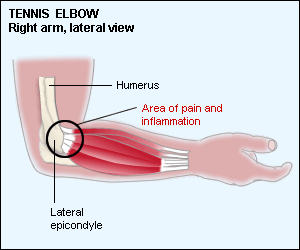Tennis elbow, or lateral epicondylitis, is a painful condition of the elbow, and as a result of overuse. Unsurprisingly, playing tennis and other racquet sports can end in this problem. However, there are many other sports and activities that may also place you at risk. The majority of people who get this are between 30 and 50 years of age.
Tennis elbow is an inflammation of the tendons that join the forearm muscles on the outside of the elbow. The forearm muscles and tendons become damaged from overuse – consequently repeating the exact same motions repeatedly. This results in pain and tenderness on the outside of the elbow, which may radiate into the forearm and wrist
Anatomy of the elbow
Lateral epicondylitis, or tennis elbow, involves the muscles and tendons of one’s forearm. Your forearm muscles extend your wrist and fingers, and your forearm tendons, known as extensors, attach the muscles to bone. They attach over the lateral epicondyle. The tendon usually associated with tennis elbow is termed the Extensor Carpi Radialis Brevis (ECRB).
Cause of tennis elbow
- Overuse – In the event the ECRB, it weakens from overuse, and microscopic tears form along the tendon where it attaches to the lateral epicondyle. This results in inflammation and pain. The ECRB can also be at an increased risk for damage due to its position. As the elbow bends and straightens, the muscle rubs against bony bumps and this tends to wear out the muscle eventually.

- Activities – Athletes are not the only individuals who get tennis elbow. Lots of people engage in work or recreational activities that demand repetitive and vigorous use of the forearm muscle.
- Painters, plumbers, gardeners, and carpenters are particularly susceptible to developing tennis elbow. Research indicates that auto-workers, cooks, as well as butchers, get tennis elbow more frequently than the remainder of the population.
- It can be caused by many other activities involving repetitive use of these muscles. Even using a computer keyboard or mouse incorrectly, particularly with poor posture, can also contribute.
- It is believed that the repetition and weight lifting needed in these occupations causes injury.
Symptoms & Treatment
The signs and symptoms of tennis elbow develop gradually and typically, the pain begins as mild and slowly worsens over weeks and months. Meanwhile, there is usually no specific injury linked to the beginning of symptoms. Common indications of tennis elbow include:
- Burning sensation or pain over the outer part of your elbow
- Weak grip strength
- The symptoms can worsen with forearm activity, for instance, holding a racquet, turning a wrench, or even shaking hands.
- Other symptoms can include swelling of the area, and weakness or stiffness in your forearm. Also, your dominant arm is more often affected. But note, both of your arms can be as well.
Tennis elbow is often chronic, lasting for several months. It sometimes gets better on its own within 6 months to 2 years. Approximately 80% to 95% of patients have success with nonsurgical treatment. The following below are some treatment options:
- Rest. The initial step toward recovery would be to provide your arm with proper rest. Meanwhile, you’ll need to stop involvement in sports or heavy work activities for a few weeks.
- Non-steroidal anti-inflammatory medicines. Drugs like Voltaren can reduce pain and swelling.
- Physical therapy. Specific exercises are useful for strengthening the muscles of the forearm. Your chiropractor could also perform an ultrasound, muscle-stimulating methods, or cross-friction to improve muscle healing.
- Brace. Utilizing a brace centered across the back of the forearm can also help in relieving the symptoms of tennis elbow. This will reduce symptoms by resting the muscles and tendons.
- Steroid injections. If manual therapy fails, steroids which include cortisone, are effective anti-inflammatory medicines that can be used to inject your damaged muscle to alleviate your symptoms.
